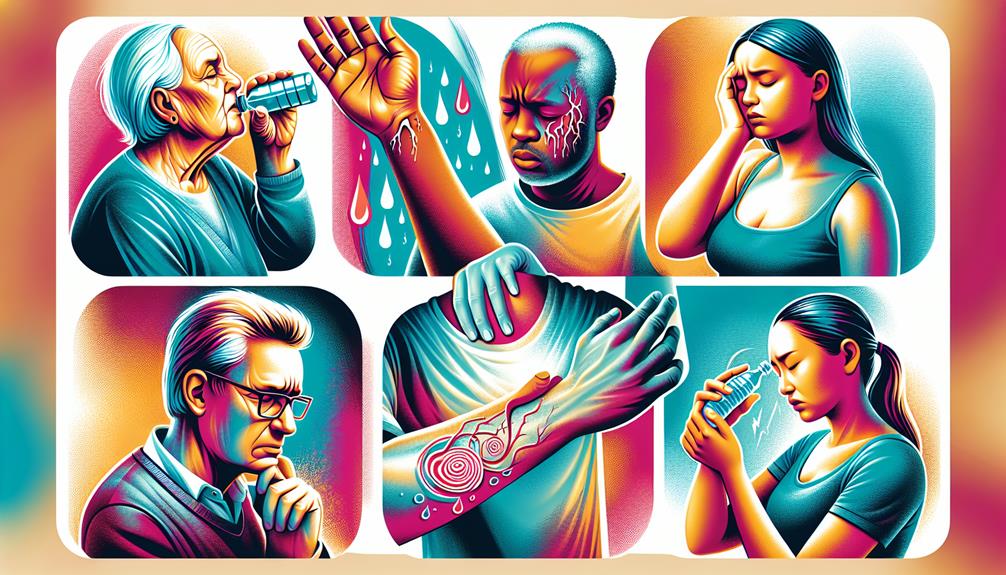
If you notice frequent urination, unexplained weight loss, extreme fatigue, and blurred vision, diabetes might be the culprit. Managing excessive thirst (polydipsia) and slow healing wounds is crucial. Fatigue stems from insulin deficiencies affecting daily life, while numbness or tingling can signify diabetic neuropathy. Darkened skin areas like acanthosis nigricans could indicate insulin resistance. Watch out for recurring infections due to compromised immune function. These symptoms are early warnings of diabetes, impacting millions of Americans. Further information on physical symptoms, complications, and risks associated with this condition awaits.
Diabetes Symptoms Key Takeaways
Early Warning Signs
If you experience frequent urination, unexplained weight loss, or extreme fatigue, these could be early warning signs of diabetes. Frequent urination, or polyuria, occurs when your kidneys work harder to absorb excess sugar in the blood. This leads to increased urine production as the body tries to expel the sugar.
Unexplained weight loss is often a result of the body's inability to properly utilize glucose for energy, causing it to break down fat and muscle tissue for fuel. Extreme fatigue is a common symptom of diabetes due to cells not receiving enough glucose, leading to a lack of energy production.
Early detection of diabetes is crucial in managing the condition and preventing complications. Monitoring your symptoms and seeking medical advice if you experience these warning signs can help in timely diagnosis and treatment. Remember, these symptoms may not always indicate diabetes, but it's essential to consult a healthcare professional for proper evaluation and guidance.
Frequent Urination
Excessive urination, known as polyuria, is a common early symptom of diabetes resulting from the kidneys' increased efforts to eliminate excess sugar from the bloodstream. When blood sugar levels are elevated, the kidneys work to filter and absorb the glucose. However, if the glucose levels surpass the kidneys' capacity to reabsorb, the excess sugar is expelled into the urine, pulling water along with it. This process leads to increased urine production and frequent urination.
Polyuria in diabetes can cause individuals to urinate more frequently than usual, both during the day and at night. The increased urine output can result in dehydration if fluid intake isn't adequately increased. Monitoring urine frequency and volume can help in identifying potential diabetes-related polyuria.
If you notice a significant increase in urination along with other symptoms like unexplained weight loss, fatigue, or increased thirst, it's advisable to consult a healthcare provider for proper evaluation and management. Early detection and treatment of diabetes can help prevent complications associated with the condition.
Excessive Thirst
Individuals with diabetes may experience an unquenchable thirst known as polydipsia, a common symptom caused by the body's response to high blood sugar levels. When blood sugar levels are elevated, the body tries to rid itself of the excess glucose through urine, leading to increased urination. This process depletes fluids from the body, resulting in dehydration, which triggers the sensation of extreme thirst.
Polydipsia is the body's way of signaling the need for more fluids to help dilute the high levels of sugar in the blood. This excessive thirst can be persistent and difficult to satisfy, even after drinking large amounts of water. It's essential for individuals experiencing diabetes symptoms such as polydipsia to monitor their blood sugar levels closely and seek medical advice to manage their condition effectively.
If left untreated, excessive thirst in diabetes can lead to complications such as electrolyte imbalances and dehydration, which can be dangerous. Therefore, it's crucial for individuals with diabetes to address polydipsia promptly to maintain proper hydration and overall health.

Unexplained Weight Loss
Unexplained weight loss in diabetes can be a significant indicator of underlying health issues related to the body's metabolism and insulin regulation. When the body doesn't have enough insulin to convert glucose into energy, it starts burning fat and muscle for fuel, leading to weight loss. This weight loss may occur even if you're eating normally or more than usual. The inability of cells to get glucose despite sufficient caloric intake results in the breakdown of fats and proteins to compensate for the energy deficit.
Monitoring your weight is crucial, as unexplained weight loss can be an early warning sign of diabetes or poor blood sugar control. It's essential to consult a healthcare provider if you experience diabetes symptoms such as sudden, unintentional weight loss. A thorough evaluation can help determine the underlying cause and ensure appropriate management to prevent further complications. Keep track of any changes in weight and discuss them with your healthcare team to address any concerns promptly.
Fatigue
Fatigue is a common symptom associated with diabetes, often stemming from the body's inability to efficiently convert glucose into energy due to insulin deficiencies. When your cells lack the necessary insulin to uptake glucose, they are deprived of the fuel needed for energy production, leading to fatigue. This constant feeling of tiredness can significantly impact your daily activities and quality of life.
To help you understand the severity of fatigue in diabetes, let's look at a comparison table showing the differences in energy levels between a person with well-managed diabetes and someone with uncontrolled diabetes:
| Aspect | Well-Managed Diabetes | Uncontrolled Diabetes |
|---|---|---|
| Energy Levels | Stable and Sustained | Fluctuating and Low |
| Ability to Focus | Improved | Impaired |
| Physical Endurance | Moderate | Poor |
| Recovery Time | Quick | Prolonged |
| Overall Well-Being | Good | Poor |
Understanding the impact of fatigue in diabetes is crucial for managing your condition effectively and enhancing your quality of life.
Blurred Vision
Blurred vision in diabetes results from fluctuations in blood sugar levels affecting the eye's ability to focus correctly. When blood sugar levels aren't well controlled, the lens inside the eye may swell, leading to changes in its shape and thus causing blurred vision. This condition is often temporary and can improve once blood sugar levels are brought back into the target range.
Additionally, high blood sugar levels can also cause damage to the blood vessels in the retina, a condition known as diabetic retinopathy. This can further contribute to vision problems and even lead to permanent vision loss if left untreated.
It is crucial for individuals with diabetes symptoms such as experiencing blurred vision to promptly consult with their healthcare provider. Proper management of blood sugar levels through medication, diet, and lifestyle changes can help prevent and alleviate blurry vision associated with diabetes. Regular eye exams are also important to monitor any diabetic-related eye complications and preserve vision health.

Slow Healing Wounds
Poorly managed diabetes can lead to delayed wound healing, posing serious risks for individuals with the condition. When blood sugar levels are consistently high, as is often the case in diabetes, nerve damage and poor circulation can occur. These complications hinder the body's ability to heal wounds efficiently.
In diabetes, slow healing wounds are a common issue due to various factors. High glucose levels can damage blood vessels and affect the immune system, impairing the body's natural healing processes. Additionally, neuropathy, a condition where nerves are damaged, can lead to decreased sensation in the extremities, making individuals less likely to notice injuries that require attention.
Proper wound care is crucial for individuals with diabetes to prevent complications such as infections and ulcers. Monitoring blood sugar levels, keeping wounds clean and bandaged, and seeking medical attention for any non-healing wounds are essential steps to promote healing. Ultimately, managing diabetes effectively is key to reducing the risks associated with slow healing wounds.
Numbness or Tingling
When diabetes affects nerves, it can manifest as numbness or tingling sensations in the extremities, signaling potential complications that require attention. This condition, known as diabetic neuropathy, arises due to prolonged high blood sugar levels damaging the nerve fibers. The tingling or numbness often starts in the toes and feet, gradually moving upwards. It may also lead to sharp, shooting pains or a loss of sensation, increasing the risk of injuries going unnoticed. Early detection and management are crucial to prevent further nerve damage.
| Symptoms | Description | Importance |
|---|---|---|
| Numbness | Loss of sensation | Indicates nerve damage |
| Tingling | Prickling sensation | Early sign of neuropathy |
| Shooting pains | Sudden, sharp discomfort | Requires medical attention |
If you experience diabetes symptoms such as persistent numbness or tingling in your extremities, consult a healthcare provider promptly. Proper blood sugar control, medications, and lifestyle adjustments can help manage diabetic neuropathy and prevent further complications. Regular monitoring and addressing symptoms promptly are key to maintaining nerve health.
Recurring Infections
Recurring infections in individuals with diabetes pose a significant health concern due to compromised immune function resulting from fluctuating blood sugar levels. Diabetes weakens the immune system, making it harder for the body to fight off infections. High blood sugar levels provide an ideal environment for bacteria and fungi to thrive, increasing the risk of infections in various parts of the body.
One common infection seen in diabetic individuals is urinary tract infections (UTIs). The elevated sugar levels in the urine create a breeding ground for bacteria, leading to recurrent UTIs. Skin infections are also prevalent, such as fungal infections like athlete's foot or bacterial infections like cellulitis. Poor circulation and nerve damage in diabetes can further exacerbate skin infections.
Respiratory infections like pneumonia and sinusitis are more frequent in diabetics due to impaired lung function and reduced ability to clear pathogens. Dental infections, such as gum disease, are also a concern. Proper blood sugar management, good hygiene practices, and timely medical intervention are crucial in preventing and managing these recurring infections in individuals with diabetes.
Darkened Skin Areas
Individuals with diabetes may experience darkened skin areas, a condition known as acanthosis nigricans, which is often associated with insulin resistance and high levels of circulating insulin. Acanthosis nigricans presents as velvety, thickened, and darkened patches of skin, commonly appearing in body folds and creases such as the neck, armpits, and groin. The darkening occurs due to an overgrowth of skin cells and an increase in melanin production triggered by insulin stimulation of skin cells.
This skin manifestation is a visible sign of underlying metabolic disturbances in diabetes, particularly insulin resistance. The prevalence of acanthosis nigricans is higher in individuals with type 2 diabetes, obesity, and those with a family history of diabetes. Monitoring and managing blood sugar levels through diet, exercise, and medication can help improve insulin sensitivity and potentially alleviate acanthosis nigricans. Consulting a healthcare provider for proper diagnosis and management is essential to address both the skin changes and the underlying diabetes.
Conclusion
In the intricate dance of the body's internal workings, diabetes can be a silent predator, lurking beneath the surface. Like a skilled spy, it sends out subtle warning signs, urging us to pay attention before it strikes.
By recognizing the early symptoms and taking proactive measures, we can outmaneuver this stealthy adversary and safeguard our health.
Stay vigilant, listen to your body's whispers, and unravel the mystery of diabetes before it gains a stronghold.




